Physical Address
304 North Cardinal St.
Dorchester Center, MA 02124
The liver is the target of many infectious agents, most notably hepatotropic viruses such as hepatitis B virus (HBV) and hepatitis C virus (HCV). In addition, many infectious organisms can involve the liver in the setting of disseminated infection, in immunosuppressed patients, or as a medical curiosity. The major challenge facing the pathologist in diagnosing these conditions is that many of these diseases have overlapping histopathologic characteristics. Hepatitis, necrosis, or granulomas are characteristic of many liver infections, and distinguishing the exact cause often requires a meticulous search for organisms, attention to subtle morphologic clues, or, not uncommonly, clinical, epidemiologic, or serologic data. Although some organisms can be readily detected in tissue, many are not, even with the use of ancillary techniques. Furthermore, many of the ancillary techniques used to detect organisms in tissue are not widely available. Therefore, although the pattern of injury can provide a differential diagnosis, in some cases the final diagnosis relies on culture or serologic studies.
Hepatitis A virus (HAV) is an RNA virus in the Picornaviridae family. Although the incidence of HAV infection has fallen dramatically since the introduction of vaccines, it still causes approximately 60,000 infections per year and occasionally causes dramatic outbreaks with fulminant hepatitis and death. Fecal-oral transmission is facilitated by extensive viral shedding in feces during the 3- to 6-week incubation period, which reaches a maximum just before the onset of hepatocellular injury. An increasing incidence has been noted among urban homosexual men. An effective vaccine has been developed.
The signs and symptoms of hepatitis A are related to patient age. In children younger than 3 years, more than 80% of infections are clinically silent, whereas in adolescents and adults, more than 75% of cases are symptomatic. Symptoms include fever, malaise, abdominal pain, and jaundice. Marked transaminase elevations are characteristic. Approximately 100 cases of HAV-related fulminant liver failure are reported each year, predominantly in adults. Chronic infection does not occur. However, HAV infection can precipitate autoimmune hepatitis, which can progress to chronic hepatitis with fibrosis or cirrhosis.
Liver injury in HAV infection is the result of an immunopathologic response to infected hepatocytes rather than a direct cytopathic effect of the virus. The adaptive immune response is highly effective in eliminating the virus. The earliest antibody response is largely that of immunoglobulin M (IgM), with IgG production beginning shortly thereafter; therefore the diagnosis is established by the detection of anti-HAV IgM (with or without IgG). Anti-HAV IgG persists for life and confers protection against reinfection.
Acute HAV infection may be indistinguishable from other acute viral hepatitides (see discussion of hepatitis B ). However, portal plasma cell infiltrates and periportal necrosis may be prominent, causing confusion with autoimmune hepatitis ( Fig. 11.1 ). In rare cases, perivenular cholestasis with relatively little inflammation mimics cholestatic drug reactions. Fibrin ring granulomas have been reported.
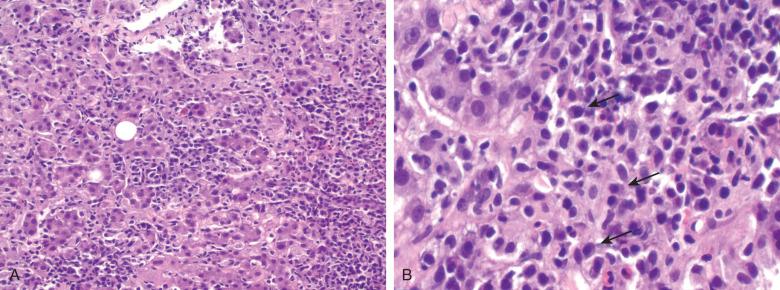
Chronic hepatitis B affects an estimated 400 million persons worldwide, of whom 1 million die annually. Three-quarters of patients with chronic hepatitis B in the world are Chinese, and sub-Saharan Africa also has high prevalence. In the United States the incidence of newly acquired HBV infection has been declining due to screening of pregnant women, vaccination, and safer injection practices.
HBV is a DNA-containing virus with four overlapping open reading frames. Its four genes are core, surface, X, and polymerase genes. The core gene encodes the core nucleocapsid protein, which is important in viral packaging, and hepatitis B e antigen (HBeAg). The surface gene encodes pre-S1, pre-S2, and S protein, which are large, middle, and small surface proteins, respectively. The X gene encodes the X protein, which may be important in carcinogenesis. The polymerase gene encodes a large protein that has a role in packaging and DNA replication.
There are eight major HBV genotypes: A is pandemic, B and C are found in Asia, D in southern Europe, E in Africa, F in the United States and South America, G in the United States and France, and H in South America. To some extent, genotype influences the severity of hepatitis and its outcome. The severity of chronic hepatitis is greater with genotype C than with B, and there is a higher frequency of cirrhosis and hepatocellular carcinoma (HCC) in patients infected with HBV genotype C. A higher rate of virologic response is achieved among patients infected with genotype B, compared with genotype C.
Hepatitis B is not directly cytotoxic to hepatocytes. Instead, the pathogenesis of HBV infection is related to the host immune response to viral infection. More vigorous immune responses cause more severe liver injury. Patients with a vigorous immune response may suffer fulminant infection with severe liver injury followed by rapid viral clearance, whereas hosts with less vigorous immune responses may become asymptomatic carriers.
Transmission of HBV is parenteral. In developed countries, sexual contact, intravenous drug use, acupuncture, and transfusion constitute the most common modes of transmission. In developing countries, vertical transmission is more significant.
Acute hepatitis B manifests as an icteric illness after an incubation period of 6 weeks to 6 months in up to 50% of infected persons. A subset of patients experience a prodromal phase characterized by arthralgias and urticarial skin rash. Acute infection is diagnosed by the detection of hepatitis B surface antigen (HBsAg), IgM antibodies to hepatitis B core antigen (anti-HBcAg), and HBeAg. The outcome of acute hepatitis depends on the immune status and age of the host. Chronic HBV infection develops in as many as 90% of neonates and infants but in only 1% to 5% of immunocompetent adults. Patients with chronic HBV infection rarely have extrahepatic manifestations, such as polyarteritis nodosa or glomerulonephritis. Many remain asymptomatic until they present with cirrhosis, HCC, or both.
The presence of HBsAg in serum for 6 months or longer is indicative of chronic HBV infection. Chronic HBV infection manifests in one of several well-defined stages. The immune tolerance phase is seen largely in patients who acquire infection at birth or in early childhood. These patients have high levels of HBV replication but little to no liver inflammation and normal serum aminotransferase levels. Serum HBeAg is detectable, and HBV DNA is markedly elevated. As the host immune system matures, the patient enters the immune clearance phase, which is characterized by immune-mediated liver injury. Patients who acquire infection as children come to clinical attention in this stage, and those who acquire infection as adolescents or adults have a very short or no immune tolerance phase and rapidly move into this second phase of the infection. Viral levels decrease, but HBV DNA is still elevated, and HBeAg is detectable. Serum aminotransferases increase, and liver histology shows active chronic hepatitis with evolving fibrosis. Although most patients remain asymptomatic, some present with flares that mimic acute hepatitis, and this may precede the development of antibodies to HBeAg and remission of hepatitis activity. Spontaneous seroconversion to anti-HBeAg antibody (HBeAb)-positive status occurs in up to 90% of white adults with chronic hepatitis B within 10 years of follow-up, and it is more likely in those with high transaminase levels, which indicate a vigorous immune response to HBV.
Seroconversion is followed by the low or nonreplicative HBsAg carrier stage, characterized by normalization of aminotransferases and low or undetectable HBV DNA levels. Histologically, minimal to mild hepatitis with variable fibrosis is seen. Most patients remain in this stage, particularly if they acquired the infection as adults; viral clearance may occur, but in patients with established cirrhosis, monitoring for HCC must continue. Up to 20% of patients serorevert to HBeAg-positive status, with a flare of activity. In approximately 20% of patients, chronic hepatitis recurs without seroreversion; this is known as HBeAg-negative chronic hepatitis, due to mutations in the precore or core-promoter regions of the HBV genome. In this phase, despite the presence of HBeAb and the absence of HBeAg, HBV DNA is detectable, serum aminotransferases rise, and histologic examination of the liver shows chronic hepatitis. However, patients with HBeAg-negative chronic hepatitis tend to have lower HBV DNA levels than patients with HBeAg-positive chronic hepatitis and to have a more fluctuating course. In addition, they are generally older and have more advanced liver fibrosis. Resolved chronic hepatitis B is defined by the loss of HBsAg and acquisition of antibody to HBsAg. Approximately 0.5% of persons with inactive chronic hepatitis clear HBsAg yearly, and most of these will develop antibodies to HBsAg. However, covalently closed circular DNA remains in the nucleus of hepatocytes, even in patients with serologic evidence of resolved infection, and poses a livelong risk for reactivation of infection.
Cirrhosis develops at an annual incidence of 8% to 10% in patients with HBeAg-negative chronic hepatitis and 2% to 5% in patients with HBeAg-positive chronic hepatitis. Cirrhosis is the major risk factor for the development of HCC; the annual incidence of HCC is 1% for HBV carriers without cirrhosis and 2% to 3% for those with cirrhosis. The risk factors for cirrhosis and HCC are similar and include high HBV DNA levels, HBeAg positivity, older age, and male gender. Additional risk factors for HCC include abnormal alanine aminotransferase (ALT) levels, long duration of infection, coinfection with HCV or hepatitis D virus (HDV), a family history of HCC, excessive alcohol intake, cigarette smoking, HBV genotype C, and core-promoter mutations.
Acute HBV infection is indistinguishable from other forms of acute viral hepatitis. Portal tracts exhibit a moderate to marked lymphocytic infiltrate. Lobular mononuclear inflammation is associated with widespread lobular injury in the form of hepatocyte ballooning, although in the early stages the injury may be confined to centrilobular regions. Numerous acidophil bodies, canalicular cholestasis, and Kupffer cell hyperplasia may be seen. In more severe cases, bridging necrosis may span between portal tracts and central veins. Panacinar necrosis or multiacinar necrosis may also be a feature. Fulminant cases are characterized by submassive or massive necrosis with marked ductular reaction. Numerous macrophages laden with lipofuscin and hemosiderin may be seen in necrotic areas. Hepatic lobular regeneration may also be evident, with mitotic figures and lobular disarray. The latter can be highlighted by reticulin stains, which serve to delineate the loss of normal hepatic plate architecture.
The histology of chronic hepatitis B varies according to the phase of the disease and host immunity. The immune tolerance phase may show no or minimal portal and lobular inflammation and no fibrosis, despite rapid viral replication ( Fig. 11.2 ). In the immune clearance phase, chronic hepatitis B shows portal mononuclear infiltrates with interface hepatitis and variable fibrosis ( Fig. 11.3 ). Varying degrees of lobular necroinflammatory activity are present, but typically not to the extent seen in acute viral hepatitis. Hepatocyte anisonucleosis may be conspicuous. A characteristic feature of chronic HBV is the presence of ground-glass hepatocytes ( Fig. 11.4 ), which contain HBsAg. These hepatocytes show a finely granular cytoplasmic inclusion that displaces the nucleus and is surrounded by a pale halo. Ground-glass hepatocytes can be demonstrated by various histochemical stains, such as Victoria blue, orcein, or aldehyde fuchsin, and by immunohistochemical stains for HBsAg. In some cases the hepatocyte nuclei have a “sanded” appearance due to the accumulation of HBcAg, although these are difficult to recognize and also are seen in delta hepatitis.
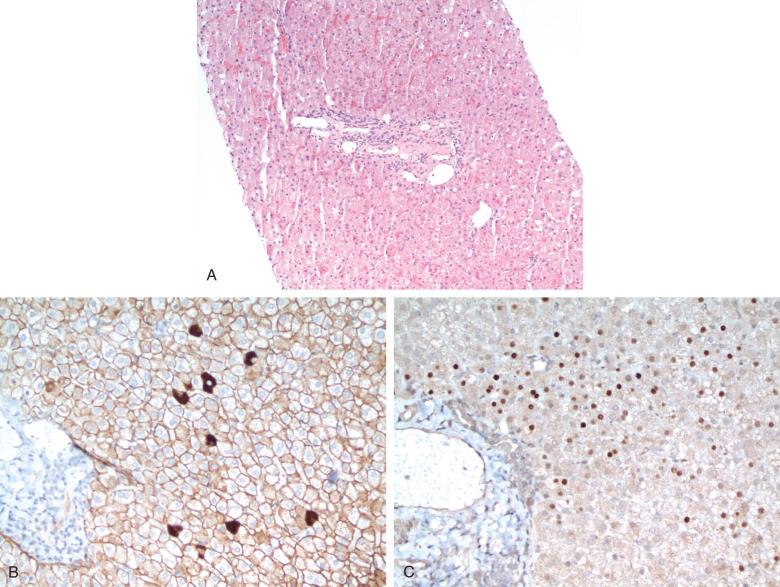
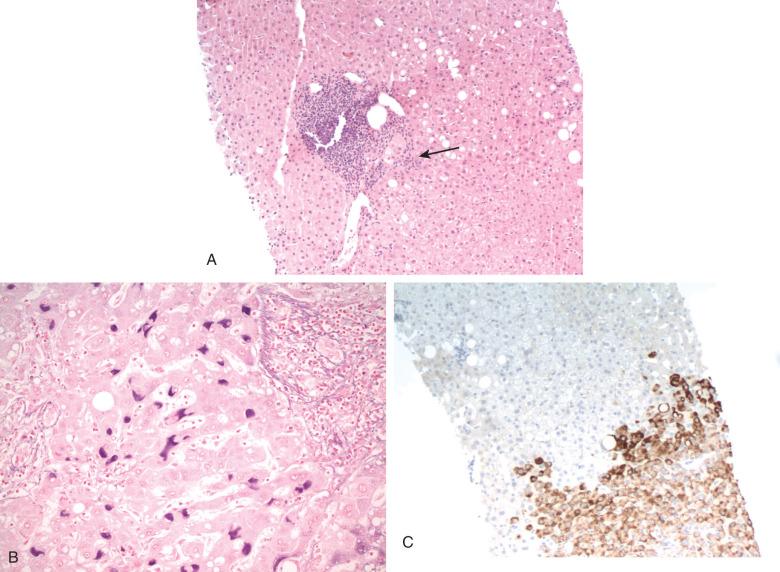
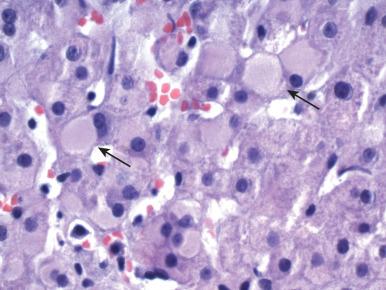
Immunohistochemistry for HBV antigens can be used to evaluate the pattern of antigen expression, which correlates with viral replication and disease activity ( Table 11.1 ). Membranous expression of HBsAg in hepatocytes with strong cytoplasmic expression in individual hepatocytes indicates high viremia and is seen in the immune tolerance phase. In contrast, cytoplasmic expression of HBsAg in clusters of hepatocytes is more often seen in patients with low or absent viremia and without active viral replication; these cells contain integrated HBV DNA, and clonal expansion of such cells may explain their clustering.
| HBsAg | HBcAg | |||
|---|---|---|---|---|
| Membranous | Cytoplasmic | Nuclear | Cytoplasmic | |
| Immune tolerance phase | ++ | ++ (individual cells) | ++ | − |
| Immune clearance phase | −/+ | + (individual cells) | + (few cells) | +/− |
| Low-replication states (chronic carriers) | − | ++ (clustered cells) | −/+ (rare cells) | − |
| HDV/HCV coinfection | + | +/− | − | − |
| HBV in immunodeficiency states | ++ | +/− | ++ | + |
Expression of HBcAg can be cytoplasmic, nuclear, or a mixed pattern. Nuclear expression correlates with the degree of viral replication and the level of HBV DNA ; biopsy specimens from patients in the immune tolerance phase or from immunosuppressed patients often show widespread nuclear staining, whereas those from patients with chronic hepatitis and low-replicative states have rare positive nuclei. Cytoplasmic HBcAg expression is associated with active liver damage and higher ALT level, suggesting that HBcAg is the likely target for immune-mediated cytolysis. Coinfection with delta virus can suppress HBcAg production and is one possible cause of a negative HBcAg stain in the setting of active hepatitis.
In general, immunohistochemistry findings for HBV antigens are negative in acute or fulminant hepatitis. Presumably, the inability to detect HBV antigen expression is a result of the short time interval of infection and insufficient accumulation of the proteins in hepatocytes to permit detection by immunohistochemistry.
The management of chronic HBV infection has improved significantly in the past decade with the introduction of nucleoside and nucleotide analogues. These agents are orally administered, well tolerated, and very effective at suppressing HBV DNA replication. However, HBsAg clearance is rarely observed, and lifelong therapy is often required. Because lifelong treatment exposes patients to adverse reactions and high costs and may induce viral resistance, the question of when to begin treatment remains an important one in the management of these patients. In general, patients with active disease benefit most from therapy. Although ALT can be an indicator of active disease, it has been shown that approximately 20% of patients with normal ALT levels have significant inflammation and/or fibrosis on biopsy, particularly among patients who are older than 35 years of age, who are HBeAg negative, or who have fluctuating ALT levels. Therefore a liver biopsy is frequently used in questionable cases to determine whether there is sufficient necroinflammatory activity to warrant therapy.
Current American Association for the Study of Liver Diseases (AASLD) guidelines recommend antiviral therapy for adults with immune-active chronic hepatitis B, whether HBeAg negative or positive. Immune-active disease is defined as elevation of ALT greater than 2 times the upper limit of normal or evidence of significant histologic disease plus elevated HBV DNA above 2000 IU/mL (HBeAg negative) or above 20,000 IU/mL (HBeAg positive). Additional factors, including gender, age, family history of HCC, and presence of extrahepatic manifestations, may be taken into consideration for patients whose ALT or HBV DNA levels do not meet these criteria. The AASLD recommends against treating adults with immune-tolerant hepatitis B, but ALT levels should be tested periodically to monitor for the transition to immune-active stage. Moderate to severe necroinflammatory activity or fibrosis on liver biopsy warrants consideration to initiate antiviral therapy.
All guidelines recommend continuing therapy in HBeAg-positive individuals at least until they achieve HBeAg seroconversion and have undetectable HBV DNA levels followed by 12 months of consolidation therapy. However, many experts feel that HBeAg seroconversion is not an acceptable endpoint and recommend therapy until HBsAg is lost, particularly in patients with advanced fibrosis or cirrhosis. Because HBsAg clearance is rare, most patients will be treated for life.
Precore and core gene mutations are associated with decreased production of HBeAg despite continued production of infectious virions. The most common mutation results in a stop codon that prematurely terminates the synthesis of HBeAg. Other mutations in the basic core promoter downregulate HBeAg synthesis at the transcriptional level. Patients infected with these mutants exhibit absent HBeAg but positive HBsAg, elevated serum HBV DNA, and elevated transaminases.
Surface gene mutations are responsible for vaccine escape. Although patients infected with these mutants are infectious, HBsAg is not detectable.
Mutations in the YMDD catalytic site of the polymerase significantly reduce the effectiveness of lamivudine and famciclovir. Despite developing this mutation, patients continue to receive some benefit from lamivudine therapy because the YMDD variant HBV exhibits reduced replication competence and reduced virulence. Discontinuation of lamivudine may cause mutant virus to revert to wild-type, with renewed efficacy of lamivudine.
HBV frequently infects liver allografts after transplantation for HBV and may lead to deterioration of graft function, although some patients enjoy excellent graft function for many years despite active viral replication. The risk of reinfection is greater after transplantation for chronic HBV infection with cirrhosis, compared with acute HBV. The pattern of hepatitis in this setting ranges from purely immunohistochemical evidence of viral antigen expression without histologic features of HBV infection, to acute hepatitis, and to chronic hepatitis with cirrhosis. Acute HBV hepatitis after transplantation may show marked ballooning and degenerative changes in the hepatocytes, scattered acidophil bodies, and extensive immunohistochemical evidence of viral antigen expression but with remarkably scant inflammation.
A distinctive pattern of hepatitis in the transplantation population is known as fibrosing cholestatic hepatitis, initially described by Davies et al. in 1991. This pattern is characterized by canalicular and cellular cholestasis, ballooning of hepatocytes, and scattered acidophil bodies with relatively scant parenchymal inflammation. Portal tracts are mildly to moderately inflamed and show periportal fibrosis, with immature fibrous tissue extending as thin perisinusoidal strands into the acinus. At the interface, a proliferation of ductal-type cells lends a hypercellularity to the portal areas. Immunohistochemical stains show extensive cytoplasmic and membranous expression with HBsAg and extensive nuclear and cytoplasmic HBcAg. The combination of high HBV antigen expression, marked hepatocyte injury, and relatively little inflammation suggests that the virus itself may be cytopathic in this setting. Fibrosing cholestatic hepatitis is associated with a high rate of viral replication, with high serum HBV DNA, high serum HBsAg titers, and rapid deterioration. It has also been described in HBV infection in other settings involving immunosuppression, including human immunodeficiency virus (HIV) infection and bone marrow transplantation.
Approximately 90% of HIV-infected persons show evidence of prior HBV infection, and 5% to 15% have chronic HBV infection. In patients coinfected with HIV and HBV, the rate of clearance of HBsAg and HBeAg is reduced, compared with non–HIV-infected individuals. This reduced clearance rate is most likely due to a weakened immune system. However, the reduced immune reaction is potentially responsible for the relatively reduced inflammation in these patients despite their higher HBV viral replication rates. Even though there is reduced inflammation, HBV infection is more progressive in HIV-positive patients, including development of cirrhosis and its complications. A pattern of hepatitis similar to fibrosing cholestatic hepatitis has been described in HIV patients with concurrent HBV infection. The HBV-related mortality in HIV patients has increased since the introduction of highly active antiretroviral therapy (HAART), possibly because of increased immunologic injury to the liver with immune reconstitution, toxicity of the antiviral drugs, or longer life spans in HIV patients. Conversely, the use of antiretroviral agents that also have activity against HBV may slow the progression of chronic HBV and even result in seroconversion, whereas their discontinuation can cause significant liver disease due to reemergence of HBV replication.
Hepatitis C affects between more than 170 million people worldwide.
HCV is an RNA flavivirus that was characterized in the late 1980s. Its genome is a positive, single-stranded RNA with a large open reading frame that encodes a 3011- to 3030-amino-acid polyprotein. This polyprotein is processed into an array of structural and nonstructural proteins. The structural proteins include the core protein and two envelope proteins, E1 and E2. The nonstructural proteins are p7, NS2, NS3, NS4A, NS4B, NS5A, and NS5B (RNA polymerase).
There are six major genotypes and more than 50 subtypes. However, the genome of HCV is highly mutagenic, and a given host carries a mixture of viral particles with closely related sequences known as quasispecies. The high mutation rate may allow the virus to escape the immune system; patients with chronic infection harbor highly diverse quasispecies, whereas those who clear the infection have low virus diversity and patients with fulminant hepatitis have the lowest level of viral diversity. Genotypes 1, 2, and 3 have worldwide distribution, but their relative prevalence varies geographically. Genotype 1a is the predominant genotype in North America (70%). In Japan, subtype 1b is responsible for up to 73% of infections. Subtypes 2a and 2b are common in North America, Europe, and Japan, whereas subtype 2c is common in northern Italy. Genotype 3 is endemic in Southeast Asia, and it is also prevalent among intravenous drug users in Europe and the United States. Genotype 4 is prevalent in North Africa and the Middle East; genotype 5 is largely confined to South Africa; and genotype 6 is found in Hong Kong, Macao, and Vietnam.
The genotype affects the rate of evolution to chronic hepatitis, the severity of liver disease, and the response to interferon (IFN) therapy. For example, genotype 1 is associated with a poor response to IFN therapy, whereas genotypes 2 and 3 respond more favorably. An association between genotype 1b and an increased risk of developing severe liver disease and HCC has been reported.
HCV is primarily transmitted parenterally, such as by recreational drug use, injection with contaminated syringes or needles, or blood transfusion. Although sexual and vertical transmission occur, they are less important with HCV than with HBV. The incidence of HCV in the United States has fallen since the introduction of widespread blood donor screening and needle exchange programs. However, since 2000, there has been an increase in the number of cases of acute HCV occurring in HIV-positive men who have sex with men (MSM).
Acute infection can be diagnosed in a variety of ways, including documentation of anti-HCV seroconversion and detection of HCV RNA in the absence of HCV antibodies. The mean incubation time for HCV is 6 to 8 weeks. Although the majority (60% to 75%) of affected patients do not experience symptoms when acutely infected, acute HCV still accounts for approximately 20% of cases of acute hepatitis. The symptoms of acute HCV are malaise, fatigue, lethargy, anorexia, abdominal pain, jaundice, mild hepatosplenomegaly, maculopapular rash, and arthralgia. Fulminant hepatitis is rare.
A minority of patients (approximately 15% to 50%) clear the infection, but most develop chronic viral hepatitis. Symptomatic onset of disease and female gender are associated with a higher chance of viral clearance after acute infection. The serologic diagnosis of chronic HCV infection is made by detection of HCV antibodies, usually by enzyme immunoassay. These assays have a 95% to 99% sensitivity and can detect antibodies 6 to 8 weeks after exposure. Polymerase chain reaction (PCR)-based methods can detect HCV RNA 1 to 3 weeks after exposure. Patients with chronic HCV infection may present with normal transaminases. These patients are often identified during blood donation or screening. The rate of progression to fibrosis or cirrhosis is very low in this group. Patients with elevated transaminases may suffer from fatigue or from nonspecific symptoms.
Extrahepatic manifestations may include mixed essential cryoglobulinemia, membranous or membranoproliferative glomerulonephritis, non-Hodgkin lymphoma, Sjögren syndrome, lichen planus, autoimmune thyroid disease, and porphyria cutanea tarda. A subset of patients with HCV demonstrate autoantibodies similar to those seen in autoimmune hepatitis, namely antinuclear antibodies (ANAs), smooth muscle antibody (SMA), perinuclear antineutrophilic cytoplasmic antibody (p-ANCA), and anti-asialoglycoprotein receptor, although often at lower titer than is typically seen in autoimmune hepatitis. Less often, liver-kidney microsomal (LKM1) autoantibodies are detected, although the epitopes recognized by these antibodies in HCV differ from those in autoimmune hepatitis type 2. Patients with autoantibodies tend to be females and to have higher transaminase levels. Some of these patients experience exacerbation during IFN-α therapy that may respond to steroid therapy, suggesting either preexisting autoimmune hepatitis or induction of autoimmune hepatitis in these patients.
The rate at which chronic hepatitis C progresses to cirrhosis depends on several factors. Factors that increase the rate of progression include male gender, older age at infection acquisition, longer duration of infection, immune suppression (e.g., HIV coinfection), HBV coinfection, alcohol use, and obesity. The risk of developing cirrhosis is approximately 20% to 30% after 10 to 20 years of infection. After cirrhosis has developed, the risk of liver disease–related mortality is 2% to 5% per year and the risk of developing HCC is 3% to 5% each year.
Acute hepatitis C is characterized by panlobular inflammation, numerous acidophil bodies, and lobular disarray similar to that seen in other acute hepatitides. A sinusoidal pattern of inflammation can mimic Epstein-Barr virus (EBV) hepatitis. More severe patterns of acute hepatitis, such as bridging necrosis or panacinar necrosis, are typically absent. Portal tracts harbor dense mononuclear infiltrates, resembling chronic HCV infection ( Fig. 11.5 ). Bile duct injury may be present. Cholestatic forms of acute HCV infection occur rarely, predominantly in the immunosuppressed population.
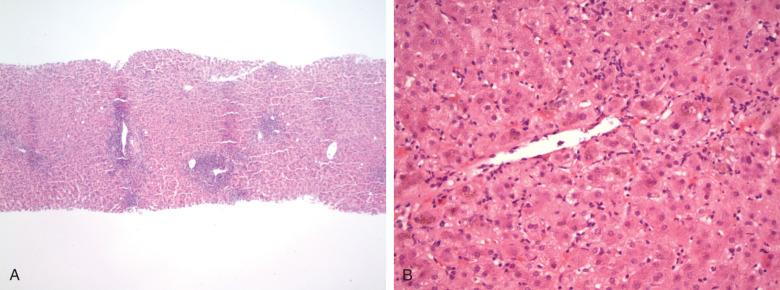
Chronic HCV infection is characterized by dense mononuclear cell aggregates or follicles in portal tracts, with mild to moderate interface hepatitis. Bile duct injury may be prominent, although typically it is mild. The lobules show scattered acidophil bodies (Councilman bodies) or foci of lytic necrosis marked by a small cluster of mononuclear cells ( Fig. 11.6 ). Kupffer cell prominence and lymphocytic infiltration of sinusoids may be seen. Variable fibrosis is present, and its extent often drives the decision of whether to treat the infection. Demonstration of virus by immunohistochemistry or in situ hybridization has been described but does not play a significant role in the routine evaluation of liver biopsies in hepatitis C.
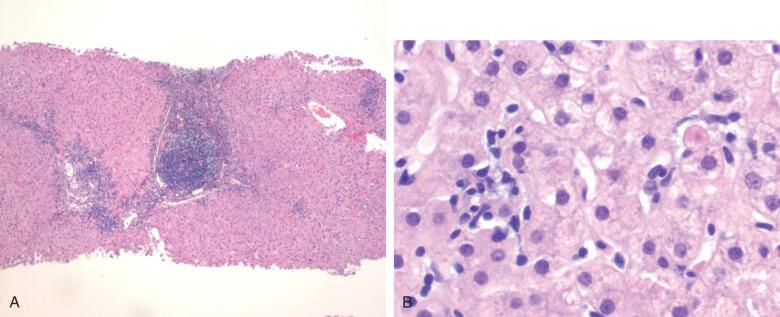
Mild to moderate steatosis is characteristic of chronic HCV infection. Steatosis may be related to direct viral cytopathic effects in patients with genotype 3 but to underlying metabolic status in patients with other genotypes. HCV core protein expression produces steatosis in mice through mitochondrial toxicity and production of reactive oxygen species. The severity of steatosis correlates with fibrosis.
Sarcoid-like granulomas are occasionally seen in liver biopsy specimens from patients with HCV. In one series, 9.5% of hepatic granulomas were attributed to HCV. In another series, 5 (10%) of 52 liver explants for HCV-related cirrhosis had granulomas for which no other cause could be identified. In a biopsy series, 14 of 155 biopsies for HCV had granulomas, but half of them could be ascribed to another cause (sarcoidosis, schistosomiasis, primary biliary cirrhosis [PBC], or mycobacterial infection). In a large series of 542 biopsies for HCV, only 2% had granulomas. In that series, the presence of granulomas predicted a better response to IFN-α therapy. Others have described granulomas in HCV after treatment with IFN-α in patients who did not respond well to IFN-α. In short, when a granulomatous process is encountered in a patient with HCV, other causes of granulomas in the liver must be rigorously excluded before they can be attributed to HCV. A history of IFN-α therapy should be sought.
The granulomas in HCV may occur in portal tracts or in the lobules. It is well known that HCV can be associated with mild bile duct injury. If the granulomas are in the portal area, their presence in conjunction with injured bile ducts may mimic PBC. Other clinical information (e.g., antimitochondrial antibody [AMA], alkaline phosphatase level) may be needed to distinguish the two.
After successful treatment of hepatitis C, most patients experience either stable or reduced fibrosis and have a reduced risk for hepatic decompensation and HCC. However, curiously, a small percentage of patients who appear to have been successfully treated for HCV actually continue to progress and may still have inflammation in liver biopsies. One factor that might explain this variable response is that patients with early cirrhosis are more likely to regress than those with advanced cirrhosis. In advanced cirrhosis, the extensive deposition of elastin and increased cross-linking of the extracellular matrix may prove more resistant to degradation. Another theory that has been proposed as a possible explanation for this phenomenon is the concept of “occult HCV” in which very sensitive assays are able to detect the presence of virus in plasma, lymphocytes, and macrophages in patients with a confirmed sustained viral response (SVR). Finally, genetic variants may be responsible because the rate of fibrosis regression differs among different ethnic groups. Patients who did not enjoy a good response to therapy tend to progress similarly to those who were not treated.
The management of HCV has changed dramatically in the past several years. From the mid-1980s until 2014, the mainstay of treatment for chronic HCV included IFN. Standard IFN therapy was administered 3 times weekly and resulted in a fluctuating HCV RNA level. By attaching a polyethylene glycol moiety to IFN (pegylated interferon [peg-IFN]), a single weekly injection became possible. The addition of ribavirin (RBV) to peg-IFN improved SVR rates and became the mainstay of therapy. This combination achieved an SVR in approximately 40% to 50% of patients with genotype 1 and in approximately 80% of patients with genotypes 2, 3, 5, and 6. An important discovery during this era was that polymorphisms of the interleukin-28B (IL-28B) gene predicted response to therapy in patients with genotype 1. Among persons with genotype 1, the non-C/C genotype (CT or TT) was associated with reduced rates of SVR.
After the HCV genome had been mapped out, it became possible to target structural components of the virus itself. Direct-acting antivirals (DAAs) target several steps in the life cycle of HCV, including NS3-NS4A, NS5A, and NS5B RNA-dependent RNA polymerase. In 2011 the first DAAs, boceprevir and telaprevir, protease inhibitors (PIs) of NS3-NS4, were approved for the treatment of chronic HCV, in combination with peg-IFN and RBV. However, the initial enthusiasm for these agents was dampened by their significant toxicity. Second-generation PIs, such as simeprevir, have fewer drug-drug interactions and less severe side effects, with increased efficacy against genotype 1.
NS5B inhibitors include nucleotide/nucleoside polymerase inhibitors (NPIs) and nonnucleotide/nucleoside polymerase inhibitors (NNPIs). NPIs are incorporated into the nascent RNA chain and cause chain termination, whereas NNPIs act as allosteric inhibitors of the polymerase. Sofosbuvir is the first NS5B NPI available in the United States and has become the backbone of HCV therapy given its high barrier to resistance, pangenotypic activity, and favorable pharmacologic profile. In 2014 IFN-free combinations became available that proved to have extremely high efficacy in achieving SVR in patients with chronic HCV, including patients considered difficult to treat, such as cirrhotics and those with genotype 1. Still, genotype may continue to be useful information in the decision of which combination to use because some, not all, DAAs have consistent activity across all genotypes and some genotypes are more likely to harbor resistance mutations. Despite the excitement IFN-free treatment of HCV has produced, the high cost of these drugs and other barriers to access remain as challenges to the eradication of HCV.
Historically, after transplantation for chronic HCV, reinfection of the graft was almost universal, although with the advent of highly successful therapy, patients will increasingly be treated before transplantation to prevent reinfection of the allograft. Although most patients do well in the long term, recurrent HCV can be progressive and can lead to graft dysfunction. The histologic features of recurrent HCV hepatitis progress from acute lobular hepatitis with scattered acidophil bodies and sinusoidal lymphocytic infiltration in the early stage to portal-based hepatitis with portal lymphoid aggregates typical of HCV infection in the chronic phase. Progressive fibrosis and cirrhosis of the graft may result. A rapidly progressive cholestatic form of HCV infection has been described in the transplantation population, similar to the fibrosing cholestatic hepatitis described with HBV. Fibrosing cholestatic hepatitis secondary to HCV has also been described in other immunosuppressed patient populations, such as in HIV patients and after heart or kidney transplantation.
In the United States and Europe 33% of HIV-infected persons are coinfected with HCV. The clearance rate of HCV after acute infection is reduced in HIV-infected patients. In chronic infection, HCV RNA levels are higher in HIV-coinfected patients, the efficacy of anti-HCV therapy is reduced, and the incidence of cirrhosis and HCC is higher. In hemophiliac patients infected with HCV, coinfection with HIV has been associated with increased severity of hepatitis and increased risk of developing cirrhosis and liver failure. Fibrosing cholestatic hepatitis related to HCV has been described in patients with HIV coinfection. With the introduction of HAART, HCV-related liver disease has become an important factor in hospitalizations and mortality of HIV patients. Patients with HCV are more likely to suffer from hepatotoxicity related to HAART and to have impaired immune reconstitution.
HDV (delta virus) is a defective, single-stranded, circular RNA virus that requires the lipoprotein coat of HBV for its replication; therefore infection from HDV alone does not occur. Eight genotypes are known; genotype 1 is the most common worldwide. There are two modes of infection: coinfection with HBV and superinfection of prior HBV infection. The severity of hepatitis in coinfection depends on the virulence of the concomitant HBV infection and ranges from mild hepatitis to severe acute hepatitis with high mortality. The usual outcome is complete recovery, and only 2% of patients develop chronic disease; resolution produces immunity to both viruses. Superinfection presents as exacerbation in a patient with preexisting chronic hepatitis or as a new hepatitis in a previously asymptomatic HBV carrier. In superinfection, chronic infection develops in more than 90% of cases. HDV infection inhibits HBV replication, resulting in little to no evidence of HBV replication, with antibodies to HBeAg and low HBV DNA. Treatment with IFN-α inhibits HDV replication, but relapse is common.
HDV infection may be associated with autoimmune manifestations in a subset of patients. Anti-liver kidney microsomal 3 (LKM3) autoantibodies are detected in 13% of patients with HDV. However, one study found liver-specific autoantibodies (anti-asialoglycoprotein receptor) and non–organ-specific autoantibodies (e.g., ANA, anti-SMA) in 60.3% and 22.1% of HBV patients, respectively, regardless of whether HDV was present. The pathology of HBV and delta virus is indistinguishable from that of HBV alone, except that the degree of inflammation and hepatocyte necrosis is often more prominent than with HBV alone. Liver specimens from an outbreak among Venezuelan Indians showed a range of histologic severity from diffuse small-droplet steatosis with focal necrosis in the earliest stages to confluent necrosis and, in the late stage, postnecrotic cirrhosis with massive collapse. Immunohistochemistry in cases of hepatitis D demonstrates delta antigen in nuclei of hepatocytes, reduced or absent expression of HBcAg, but continued expression of HBsAg.
Hepatitis E virus (HEV) is a nonenveloped, positive-sense, single-stranded RNA virus of the Hepeviridae family. There are four genotypes: genotypes 1 and 2 cause human disease in endemic areas, predominantly in developing countries, whereas genotypes 3 and 4 infect animals and cause zoonotic infections in humans in nonendemic areas. The virus is spread through fecally contaminated water or food, and epidemics have occurred in central and Southeast Asia, the Middle East, and North Africa. In contrast, genotype 3 has been detected in domesticated pigs, wild boars, deer, and rodents and can be transmitted by porcine meat.
Most often, hepatitis E presents as acute hepatitis that is clinically indistinguishable from hepatitis A, ranging from asymptomatic infection to fulminant hepatitis. Mortality rate is 1% to 4% overall, but it is approximately 20% among pregnant women. In immunocompetent individuals, there is no progression to chronic hepatitis. Although hepatitis E has been regarded as a disease largely restricted to underdeveloped countries with warm climates, it is being increasingly recognized in industrialized countries; indeed, a small percentage of presumed cases of drug hepatitis may be acute hepatitis E. Among 400 patients with acute hepatitis in Montenegro, 6% were demonstrated to have HEV by the presence of IgM anti-HEV.
In immunosuppressed patients, chronic HEV infection with prolonged viremia has been described. Chronic HEV infection occurs largely in the solid organ transplant population, but rare cases in HIV-positive individuals are described. Chronic HEV might explain some cases of otherwise unexplained chronic hepatitis in liver allografts that, in some patients, leads to cirrhosis, sometimes requiring retransplantation. Factors that predispose to chronic HEV include liver transplantation (relative to kidney transplantation) and tacrolimus immunosuppression rather than cyclosporin A. Most patients eventually clear the virus, usually because of reduced immunosuppression, although treatment with RBV and peg-IFN may be beneficial in some patients.
Serologic diagnosis of HEV infection is hampered by the high prevalence of anti-HEV in the general population and a high false negative rate in immunocompromised individuals. The prevalence of anti-HEV ranges from 6% to 53% of the population, depending on the region surveyed. For example, in a nationwide survey of blood donors in France, 22.4% of the population had IgG to HEV and 1% of the population had IgM to HEV. Areas of highest prevalence of IgG corresponded to areas of higher consumption of pork meat, raw pork liver sausage, game meat, offal, and oysters. In the United States the seroprevalence rate between 1988 and 1994 was 21%, with the likelihood of exposure increasing with age. The presence of anti-HEV IgM is required to make the diagnosis of acute infection, but specific testing may not be available in all geographic locations. A rising IgG anti-HEV titer can provide evidence of infection, and PCR for HEV RNA provides additional supportive evidence.
The histopathology of acute HEV is similar to HAV in that it usually produces classic acute hepatitis ( Fig. 11.7 ). Cases from endemic regions have been described as having ballooning degeneration of hepatocytes, apoptotic bodies, pseudorosette formation of hepatocytes, steatosis, and portal plasma cells. Cases of autochthonous HEV hepatitis due to genotype 3 show acinar and portal inflammation with lymphocytes, plasma cells, and polymorphs, with equal numbers of eosinophils and neutrophils. Neutrophilic or lymphocytic cholangitis, cholestasis, lobular disarray with ballooning degeneration, hepatocyte rosettes, perivenular edema, confluent necrosis, anisonucleosis, and Kupffer cell aggregates are also described. In transplant patients, biopsies may show mild portal and lobular hepatitis with acidophil bodies, progression to portal-based chronic hepatitis, and variable fibrosis including cirrhosis.
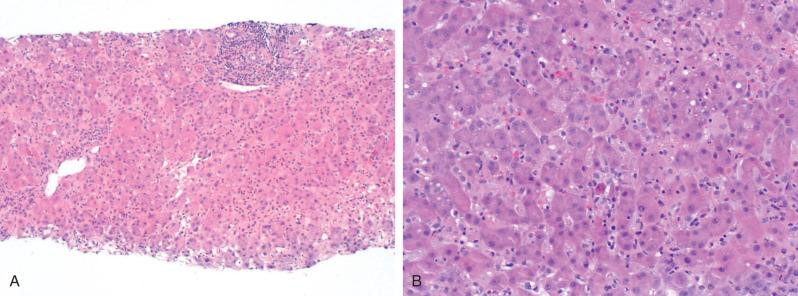
During the investigation for the cause of non-A, non-B hepatitis, a virus was discovered that was initially classified as hepatitis G but is now considered nonpathogenic. In 1966 a surgeon, George Barker (GB), became ill with acute hepatitis, and his blood was used to infect marmosets, which developed hepatitis. Serum from these animals was used to infect other primates. Eventually, two viruses were discovered in this primate group and called GB virus A (GBV-A) and GB virus B (GBV-B), after the surgeon. Attempts to isolate these viruses from humans failed, but a related virus, GB virus C (GBV-C), was isolated from patient material. Meanwhile, independent investigators discovered a novel virus that they classified as hepatitis G, and soon it was discovered that GBV-C and hepatitis G were genetically identical. Like HCV, GBV is classified as members of the family Flaviviridae .
Most immunocompetent people clear the virus in approximately 2 years, although some patients have persistent viremia. Clearance of the virus is associated with the production of antibodies to the envelope glycoprotein E2. Infection with GBV-C is worldwide and common. One percent to 4% of blood donors are viremic at the time of donation, and another 13% have antibodies. Among HIV-positive homosexual men, approximately 85% are viremic or have antibodies indicating prior infection, evidence of sexual transmission. Prostitutes also have high prevalence. Other methods of transmission are transfusion and maternal transmission.
Because GBV-C was found in patients with hepatitis and at risk of developing parenteral hepatitis, it was initially believed to be a hepatotropic virus responsible for some cases of transfusion-related hepatitis, acute hepatitis, or chronic hepatitis. However, the virus is actually lymphotropic, not hepatotropic, and no convincing association between the virus and human disease has been identified. Therefore the virus is currently believed to be nonpathogenic.
The liver is involved in more than 90% of cases of infectious mononucleosis, which is caused by EBV infection; hepatomegaly is present in 10% to 15% of cases, splenomegaly in 50%, and jaundice in only 5%. Most often, the hepatic manifestations of EBV infection consist of self-limited elevations of hepatic transaminases. Rarely, EBV hepatitis has more serious consequences, such as the induction of autoimmune hepatitis, severe hepatitis with jaundice, or liver failure.
Liver biopsy shows portal and periportal infiltrates of small and large lymphocytes, with occasional larger immunoblastic cells resembling the Reed-Sternberg cells of Hodgkin disease. A characteristic feature is sinusoidal infiltration by these same lymphocytes, which creates a beaded appearance ( Fig. 11.8 ). Bile duct injury may be subtle. Liver cell ballooning is not prominent, although hepatocyte regeneration, canalicular cholestasis, and Kupffer cell hyperplasia are variably seen. Areas of necrosis may be infiltrated by collections of mononuclear cells, creating a granulomatous appearance. Although these histiocytes usually do not form true epithelioid granulomas, well-developed nonnecrotizing granulomas and fibrin ring granulomas have been reported in patients with EBV hepatitis. In fatal cases, submassive lobular necrosis has been seen.
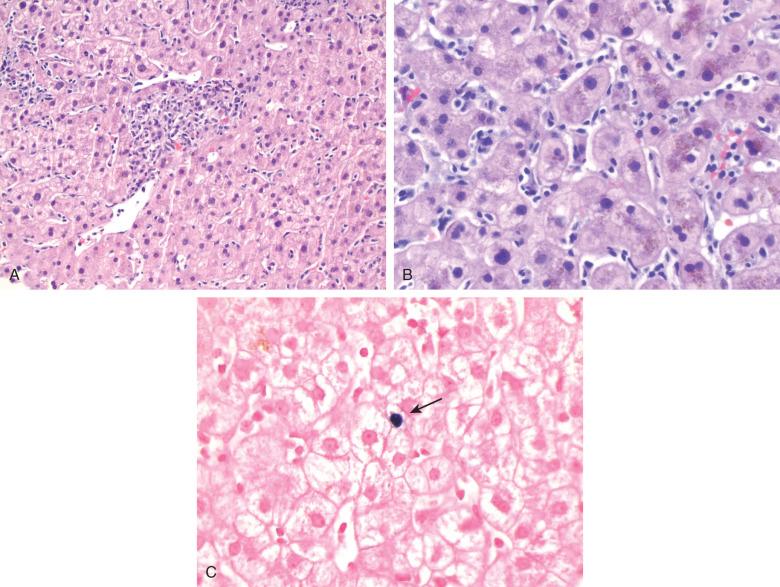
Detection of EBV is done by in situ hybridization for EBV-encoded RNA (EBER) or by PCR for EBV DNA. Immunohistochemistry for EBV latent membrane protein has not proved to be a reliable method for detecting EBV in EBV hepatitis.
In neonates, cytomegalovirus (CMV) infection has been associated with neonatal hepatitis or neonatal cholestasis, although establishing a serologic diagnosis in these cases is challenging due to maternal transfer of antibodies and poor IgM production in neonates. Several studies have found CMV DNA in the serum or liver tissue of neonates with liver dysfunction or cholestasis. The histology in these cases may resemble extrahepatic biliary atresia, with portal expansion, bile ductular proliferation, and bile stasis. Fatal cases may show widespread hepatocyte necrosis, lobular disarray with pseudorosettes, giant cell transformation of hepatocytes, and ductular metaplasia of hepatocytes. Cytomegalic inclusion bodies have been described in hepatocytes, endothelial cells, and bile duct epithelium. However, inclusions may be absent by routine histologic assessment, and immunohistochemistry or in situ hybridization may be useful, although their utility in this population has not been formally studied. CMV has also been implicated in extrahepatic biliary atresia, based on studies demonstrating CMV DNA in liver tissue, serologic evidence of CMV infection, or positive urine cultures in a subset of infants with biliary atresia. Inclusions have not been described by histologic assessment. Although intriguing, the possible association between biliary atresia and CMV may lead to delay in diagnosis of biliary atresia when a child presenting with cholestasis is found to have clinical evidence of CMV infection. Clinical evidence of CMV infection should not preclude evaluation for other causes of cholestasis, particularly biliary atresia, which requires early surgical intervention.
In adults, CMV infection is clinically mild and self-limited; CMV accounts for 8% of cases of infectious mononucleosis–like syndrome with hepatic involvement. Rare cases of massive hepatic necrosis have been reported, usually in immunocompromised hosts. In immunocompetent hosts, CMV infection can result in a histologic picture virtually identical to that of EBV hepatitis, with sinusoidal beading, atypical lymphocytes within sinusoids, lymphocytic infiltrates in portal tracts, and areas of necrosis with aggregates of Kupffer cells resulting in a granulomatous appearance. CMV infection is rarely associated with well-formed nonnecrotizing granulomas or fibrin ring granulomas. In immunocompromised patients, viral inclusions may be found in hepatocytes, endothelial cells, Kupffer cells, and duct epithelium ( Fig. 11.9 ). Virally infected cells show a large amphophilic nuclear inclusion surrounded by a halo, known as an “owl's-eye” nuclear inclusion, and coarsely granular cytoplasmic inclusions. The inclusions may be isolated, or they may elicit an inflammatory reaction that can be granulomatous or neutrophilic, the latter being especially common in transplantation patients. In fact, a pattern of “disseminated focal hepatitis” with small inflammatory foci in the lobules composed of either neutrophils or mononuclear cells should prompt exclusion of CMV in transplant patients by searching for inclusions or immunohistochemistry. In HIV-positive patients, bile duct involvement may result in sclerosing cholangitis (HIV-associated cholangiopathy). Immunohistochemical stains for CMV can highlight cells with inclusions, including atypical inclusions, and may stain infected hepatocytes that are not recognizable as infected cells on routine stains, increasing sensitivity for the diagnosis of CMV hepatitis.
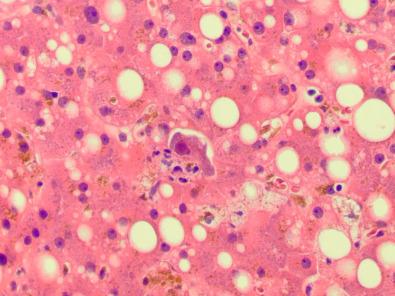
Herpes simplex virus (HSV) viremia can result in visceral involvement, affecting mainly the esophagus, lungs, and liver. Liver involvement occurs primarily in neonates, pregnant patients, and immunocompromised patients, although immunocompetent adults are rarely affected as well. Dissemination usually occurs in primary infection (particularly if the patient is immunocompetent) but has also been described in reactivation. In children, severe protein-calorie malnutrition and the postmeasles state predispose to disseminated HSV infection. Oral ulcers and skin lesions may or may not be present. HSV hepatitis is rapidly lethal and requires early recognition and institution of antiviral therapy to improve outcome.
HSV hepatitis is characterized by patchy, nonzonal coagulative necrosis with minimal to absent inflammatory response ( Fig. 11.10 ). Mild to severe fatty change may be present. Intranuclear inclusions of two types can be found in hepatocytes at the edge of the necrotic foci, and virally infected cells are often multinucleated. Cowdry type A inclusions are large, eosinophilic intranuclear inclusions surrounded by a halo, whereas type B inclusions replace the entire nucleus with a basophilic ground-glass appearance. Immunohistochemistry for herpes type I and type II antigens highlights the nuclear inclusions, and overlap between the two antibodies is frequent.
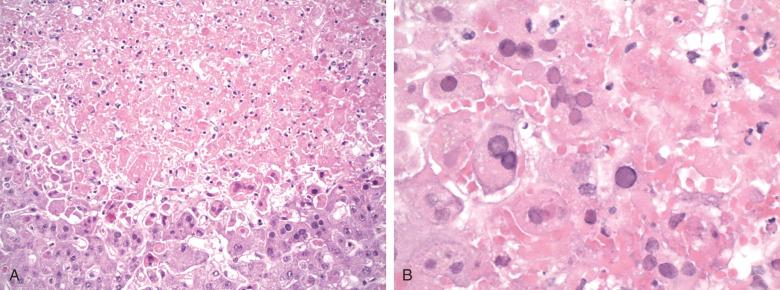
Treatment with antiviral drugs before the biopsy is obtained may result in a biopsy specimen with extensive necrosis but without diagnostic inclusions. The main differential is varicella zoster virus (VZV) infection and adenovirus infection, both of which have a similar histologic appearance; immunohistochemical staining or PCR may be necessary to distinguish these infections. HSV serologic studies are not helpful in establishing the diagnosis but virologic cultures may be positive.
Rarely, the rash of VZV can be accompanied by potentially life-threatening noncutaneous manifestations, including encephalitis, pneumonitis, myocarditis, and hepatitis, especially in immunocompromised patients, neonates, and adults. Dissemination is virtually always seen in primary infection, although dissemination in reactivation can occur in the immunocompromised patient. Primary infection in immunocompetent adults can cause severe acute hepatitis and, rarely, fulminant hepatic failure. Transplantation patients and immunocompromised patients are at higher risk for a fatal fulminant hepatitis. In children, the convalescent phase can be associated with Reye syndrome (microvesicular steatosis, hyperammonemia, coagulopathy, and cerebral edema), particularly if aspirin has been administered.
Serology is of little use, especially in the immunocompromised patient. The appearance on liver biopsy resembles HSV. Immunohistochemistry can confirm the presence of a herpes virus, but, depending on the antibody, may not distinguish which one. PCR may be necessary to distinguish HSV from VZV infection.
Although infection by adenoviruses is generally restricted to the upper respiratory tract and conjunctivae in the normal host, disseminated infection can occur in immunodeficient patients, particularly liver transplant recipients, bone marrow transplant recipients, and patients receiving chemotherapy. Sixty-four percent of cases in the literature occurred in patients younger than 18 years of age. Liver biopsies or postmortem livers in patients with adenovirus hepatitis have shown widespread necrosis with little inflammation, mild steatosis, and viral inclusions with a deep blue-purple smudged appearance ( Fig. 11.11 ). Immunohistochemistry, in situ hybridization, electron microscopy, PCR, or viral culture can be helpful in confirming the diagnosis.
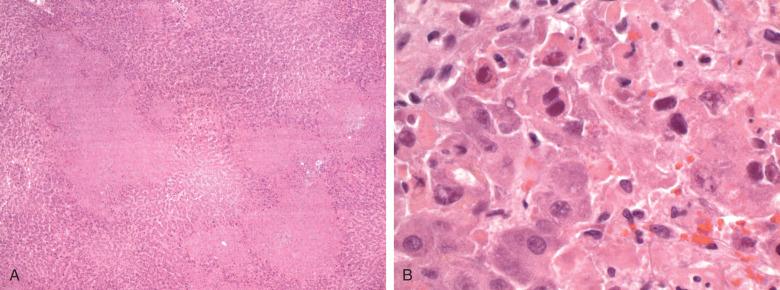
Parvovirus B19 produces several clinical manifestations, including erythema infectiosum (fifth disease) in children; hydrops fetalis; arthritis associated with acute infection in adults; various hematologic disorders (e.g., leukopenia, thrombocytopenia, transient aplastic crisis); and, rarely, involvement of other organs, including neurologic, cardiac, hepatic, and vascular disease.
The role of parvovirus B19 infection in acute or fulminant hepatitis is controversial. Several reports raise the possibility that parvovirus B19 may cause acute hepatitis, fulminant hepatitis, or fulminant hepatic failure. These cases describe several lines of evidence that implicate parvovirus B19, including the presence of parvovirus B19 DNA in the liver of patients with fulminant hepatic failure, the presence of parvovirus B19 DNA in liver tissue or serum of patients with acute or fulminant hepatitis, and the presence of IgM to parvovirus B19 in serum in patients with acute hepatitis. In patients with fulminant hepatic failure, parvovirus B19 DNA was found in liver tissue in four of six patients with associated aplastic anemia and in two of four patients without aplastic anemia but not in six patients with known causes of acute liver failure. Histology studies in these and other cases showed a range of injury, from mild lobular hepatitis to massive or submassive hepatic necrosis and collapse with either no inflammatory infiltrates or small aggregates of lymphocytes. Viral inclusions are not seen on routinely stained slides, but parvovirus VP1 antigen (a structural protein produced by the virus) was detected by immunohistochemistry in one case report. In contrast, other investigators found no parvovirus B19 DNA by PCR in 33 cases of cryptogenic acute liver failure but detected parvovirus B19 DNA in several patients with known causes of acute liver failure. In that study, several patients had low-titer IgM positivity without confirmatory PCR positivity. In another study, parvovirus B19 DNA was found with similar frequency in patients with fulminant hepatitis and with hepatitis B or C. Furthermore, RNA transcripts could not be detected in any of the liver tissue samples, arguing against active viral replication. These studies suggest that low levels of PCR positivity may reflect remote infection, and they raise questions about the role of parvovirus B19 in acute hepatitis and acute liver failure.
The role for parvovirus B19 in chronic hepatitis is equally controversial. Although there are reported cases of chronic hepatitis secondary to parvovirus B19, studies have shown that parvovirus B19 DNA can persist in liver tissue for prolonged periods. Whether coinfection with parvovirus B19 worsens the prognosis of patients with hepatitis B or hepatitis C is uncertain. Some studies found that coinfected patients have more severe disease, but most studies do not corroborate that finding.
Become a Clinical Tree membership for Full access and enjoy Unlimited articles
If you are a member. Log in here